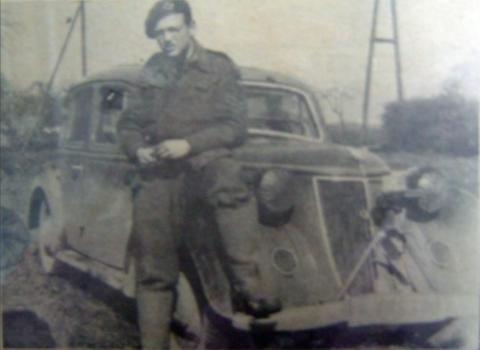Cpl Lewis Stagnetto 317 (Airborne) Field Security Section, The Intelligence Corps
In 1942 Lewis Stagnetto volunteered, aged 18, at Glasgow where he had been studying medicine. As a Gibraltarian, his enlistment in the Highland Light Infantry was complicated, by his then “colonial” status.
Whilst still under basic training, a requirement for linguists was announced. His fluency in Spanish and near fluency in French rendered him suitable for Field Security duties and a transfer to the Int Corps. Further volunteering for parachuting duties, he then completed parachute training at Hardwick and Ringway.
The now Cpl Stagnetto, however, was sent from 1025 FSRD (Field Security Reserve Detachment) at Highgate to Normandy by sea, on 14 June 1944. Moving forward, he assisted with the organisation of Maquis elements into cohesive fighting forces mainly for the protection of personnel (possibly SOE operatives, locally perceived to be collaborators) in the Cherbourg area, then threatened by German, Allied and Free French action.
At the conclusion of the Normandy Campaign, he was promoted Sgt and posted to 317 (Airborne) FSS, in 6th Airborne Division which returned to the UK in September 1944.
The German offensive in the Ardennes, otherwise known as the Battle of the Bulge, saw the Division alerted on Christmas Eve and deployed to snowy Belgium a few days later. The Division were Headquartered at Cierngon and, whilst passing through Jmelle, near Rochefort, to Div HQ, Sgt Stagnetto noticed that the helmets of the troops ijn the town appeared a different shape – it dawned on him that Jmelle was still in the hands of the Germans. Already posted “Missing in Action” by the he was able to inform the HQ Intelligence staffs of this on arrival!
After a short sojourn back in England, 317 FSS as part the Division were deployed on Op VARSITY, 24 March 1945.
In daylight at 10:30 am, the Divisional landing zones surrounded the German town of Hammilkeln. The Germans were prepared.
Gliders do not always land where they are supposed however, with Sgt Stagnetto in one of these “strays”. Landing approximately 30km from the correct landing zone, his Horsa glider landed adjacent to a farmhouse. The glider contained over 40 (from Sgt Stagnetto’s account) troops who, realising their predicament immediately took over the farmhouse and prepared defensive positions.
German forces in the area quickly became aware of the airborne troops, and fiercely attacked using armoured vehicles and mortars. Failing to overrun the dogged (and now mostly wounded) defenders, a number of German prisoners were taken. At Sgt Stagnetto’s instigation, were stripped of their trousers and boots to stop them potentially escaping and causing more trouble.
317 FSS then quickly re-grouped and took part in the Division’s six week march to the Baltic. “One mad, quick, advance”, saw the Division at the fore front of British forces. On the way to the Baltic, 317 FSS and Sgt Stagnetto (who may have been one of the first to enter) were part of the force that discovered the Concentration Camp at Bergen-Belsen. Sgt Stagnetto, using the FSS camera, took some of the first pictures of the site, recording the worst of Nazi atrocities for Divisional HQ.
At Wismar, on the Baltic coast, the Division complete with 317 FSS saw in VE Day. They met with Russian forces (who Sgt Stagnetto immediately distrusted). With only minor damage to the premises, 317 were lucky to escape death or wounds from a grenade thrown into the FSP by a disgruntled former Nazi just after VE Day.
His next posting, as a senior NCO, with operational experience, was to the Middle-East School of Military Intelligence, at Almaza, Cairo. His 5 months as instructor at the School lead him to consider the military as a regular career, but his “colonial” status - with over 3 years active service, allowed him “immediate release”.
His application was approved. On return to Gibraltar – having not been home since 1941, he joined the family firm, Gibraltar’s largest importer of wines & spirits and tobacco products. The formation of the Gibraltar Reserve Regiment saw his commissioning and taking a Company.
He continued to live a rather full life, becoming Chairman of Gibraltar’s Chamber of Commerce and being active across the community. His far too early death, in 1976, robbed Gibraltar of one of its most prominent figures.
Created by Mark Pitt
Read More

Latest Comments
There are currently no comments for this content.
Add Comment
In order to add comments you must be registered with ParaData.
If you are currently a ParaData member please login.
If you are not currently a ParaData member but wish to get involved please register.